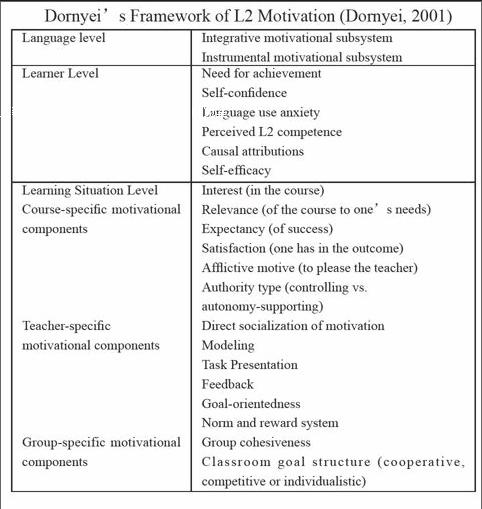Classification and Implication of Motivation Research in SLA
2015-04-23温泉
温泉


Introduction
The author of this essay does not intend to clarify the controversy about motivation in Second Language Acquisition (SLA) as a critical social-psychological element in the field, because the research of motivation is such a complex process which requires some degree of expertise in three scholarly domains as language education, applied linguistics and psychology.(Dornyei,1990).As William (1997) commented that “there is no room for simplistic approaches to such complex issues as motivation.” The essay only wishes to categorize three main researching aspects of motivation for the intermediate learners in SLA to help them obtain a general researching outline when studying about motivation.So the essay mainly cover the two parts: Classification and Implication, which are the diverse categorizing principle and the approaches derived from motivation study to enhance second language teaching and learning.
I.The Two Popular Three-Fold Categorization
1.Global Motivation, Situational Motivation and Task Motivation
Brown classifies motivational elements into three aspects: global motivation, situational motivation and task motivation.Global motivation refers to the general attitude towards language learning; situation motivation means the moving power generated from the good learning circumstances, such as the teachers warm personality, the suitable teaching and learning approaches and the materials and task motivation comes from the well-designed tasks the teachers provide.This classification has its merit, but it leaves the researchers a too complicated and abstract concept of global motivation which in broader sense conclude the latter two.
2.Motivation on Language Level, Learner Level and Learning Situation Level
Following Crookes and Schmidts (1991) approach of examining motivation at various conceptual levels, Dornyei (1994a) drew up the frame work of L2 motivation which vividly illustrated the three basis constituents of L2 learning process --- the target language, the language learner and the language-learning situation, which in large sense reflect the three dimensions of the language --- the social, the personal and educational.
Dornyei made his own contribution two the research of motivation in SLA through his extended motivational frame work.Although William and Burden (1997) later conceived a more comprehensive framework of L2 motivation as the social constructivist model, it is still easy to find some shadow from Dornyei.So lets have a detailed discussion about Dornyeis framework which has the bird-eye view on motivation in order to deduce the implication.
The analysis of Dornyeis framework on motivation at three levels provide us with the prerequisite for exploring the implication on how to promote motivation for the language learners.
II.Implication of the research for language teaching and learning
How to motivate the language learners?
Thanks to the three-fold framework, the answer to this question also involves three interrelated factors coming from the language, the learner and the learning situation.
First of all, teacher should lead learners to realize the importance of the target language and stimulate their interest and desire to learn it well so that they can communicate with the target group members in real life.Secondly, teacher should help learners to establish a proper cognitive attitude towards the difficulties and failures in language learning.It is showed in the study of psychology, learners with high achievement motivation always attribute their success and failure to the efforts they have made, on the contrary, those who are with low achievement motivation ascribe their success and failures to those exterior factors such as luck and difficulty of the task.So it is the teachers duty to enhance the learners self-efficacy and self confidence.Last but not the least, teacher are supposed to create an education-friendly leaning situation to motivate the learners.For example, teaching methods should be diverse instead of being routine mode, teachers feedback should be supportive instead of being demotivated and activities of cooperation should be strengthened instead of competitiveness.
The research on motivation in SLA flourished in China during the past decade, because an increasing number of educationists and psychologists have realized the importance of this study.In the Chinese context, Wen (2001), Qin (2002) and Gao & Zhang (2006) offered us an agreement after investigating more than ten thousand non- major college students that the majority of the Chinese college students are learning English with strong instrumental or extrinsic motivation --- to get the certificate by sitting for the exam like College English Test and to secure a good job in the future.Though Gardner and Lambert (1959) suggested that instrumental motivation plays a prior function in stimulating a language learner, it is still a pity that the Chinese learners are reported to feel pushed and even disgusted to learn it.Zeng (2006) has done a very interesting survey and comparison on the different motivations in SLA between college students in E.U.and the ones in China.The following chart showed the comparison: ( more impressive if demonstrated in pie charts)
So as can be seen from the above, how to promote the integrative and intrinsic motivation of the language learners seem to be the most challenging task for the Chinese educationists and psychologists dedicated in the area of SLA.
Conclusion
It seems to be a frustrating attempt to explore the issue of motivation in SLA, because it is such a complicated factor involving the expertise in linguistics, education and psychology.However it must be an inspiring practice to have a bird-eye view on it through the help of Dornyeis framework on motivation at three levels which are doomed to be the most effective way to understand the elements concerning about motivation.This essay has its limitation since it can not cover all the details due to the restriction on number of words, but it does point out the most important fact that to stimulate the motivation in all possible aspects will surely result in high autonomy and efficiency in language learning, which will in turn foster a more motivated mind in the learning.
References:
[1]Crookes, G., & Richard, W.S., 1991, Reopening the Research Agenda[J].Language Learning 41.
[2]Dornyei, Z., 1990, Conceptualizing Motivation in Foreign Language Learning[J].Language Learning 40.
[3]Dornyei, Z., 1994, Motivation and Motivating in Foreign Language Classroom[J].Modern Language Journal.
[4]Dornyei, Z., 2001, Teaching and Researching Motivation[M].Pearson Education Limited: London.
[5]Gardner, R.C.& Lambert W.E., 1959, Motivational Variables in Second Language Acquisition[J].Canadian Journal of Psychology 13.
[6]William, M.& Burden, R.L., 1997, Psychology for Language Teachers[M].Cambridge University Press: Cambridge.
[7]高玉娟,张世霞.中国大学生第二语言学习动机的调查与分析[J].大连理工大学学报:社会科学版,2006(1):72-76.
[8]秦晓晴.大学生外语学习归因倾向及其对归因现象的理解[J].现代外语,2002(1):71-78.
[9]文秋芳,英语学习者动机、观念、策略的变化规律与特点[J].外语教学与研究,2001(2):105-110.
[10]曾丽,中国大学生与欧洲大学生外语学习动机的差异比较研究——浅谈中国大学英语教学改革[J].贵州民族学院学报,2006(1).
猜你喜欢
杂志排行
校园英语·中旬的其它文章
- A Comparative Study on the Two Chinese Versions of Gone with the Wind: from the Social Linguistic Perspective
- Has the emergence of English as a Lingua Franca been an entirely beneficial phenomenon for both native and non—native English speakers
- 概念整合理论下言语幽默分析
- A Brief Contrastive Analysis between English and Chinese
- Influence of behaviorism to American descriptive linguistics
- Language: a social mirror
